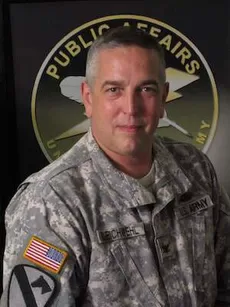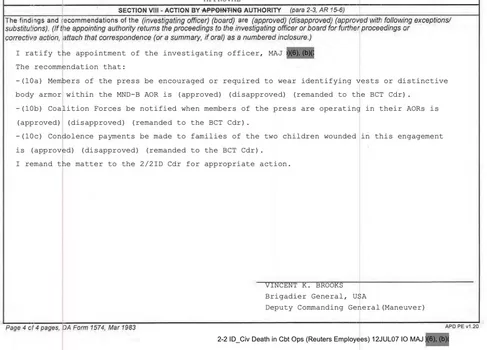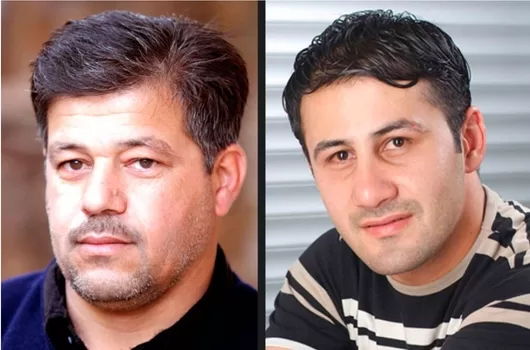As a former Reuters photographer, I feel compelled to look into what happened that day and ask if the military response was appropriate and proportionate. Just a forensic account of who said and did what in the hours and months after the slaying of Namir Noor-Eldeen and Saeed Chmagh which was shown in the Wikileaks Collateral Murder video.
Let’s look at the first stories filed. The U.S. military said in a statement issued after midnight, early on 13 July, 2007 that Namir and Saeed were killed in a firefight with insurgents.
Reuters photographer Namir Noor-Eldeen, 22, and assistant/driver Saeed Chmagh, 40, both Iraqis, were shot dead by a U.S. Apache helicopter on the streets of Baghdad on July 12, 2007, along with 10 other people. Two innocent children were among the injured.
Former Reuters journalist Dean Yates was the bureau chief in Baghdad when his Iraqi colleagues were killed. On the day of the shooting, Reuters filed the following story, complete with a US military statement which contradicted eye witness accounts. An excerpt …
Reuters photographer and driver killed in Iraq
“LONDON (Reuters) 12 July, 2007 – An Iraqi photographer and driver working for Reuters in Iraq were killed in Baghdad on Thursday in what witnesses said was a U.S. helicopter attack but which the military described as a firefight with insurgents.”
“Iraqi police blamed American military action for the deaths.”
“The U.S. military said the pair died after a clash between its troops and insurgents. The incident was under investigation, it said in a statement.”
“U.S. and Iraqi forces engaged “a hostile force” after coming under fire and attack aircraft were called in.”
“Nine insurgents and two civilians were killed, the military said. The “two civilians were reported as employees for the Reuters news service,” it added.”
“A preliminary police report obtained by Reuters said Noor-Eldeen and Chmagh had been killed by a “random American bombardment” that had killed nine other people.”
“The report was issued by the al-Rashad police station, the closest station to the scene. Reuters obtained a photocopy of the report. It was based upon witness accounts of the incident and signed by a lieutenant-colonel, the head of the station.”
“The deaths take to six the number of Reuters employees killed in Iraq since U.S.-led forces invaded the country in 2003 to topple Saddam Hussein.”
“Noor-Eldeen and Chmagh’s outstanding contribution to reporting on the unfolding events in Iraq has been vital. They stand alongside other colleagues in Reuters who have died doing a job that they believe in.”
Excerpt from Reuters story filed 12 July, 2007 by Reuters Staff
Reuters photographer and driver killed in Iraq
The U.S. military said in a statement issued after midnight, early on 13 July, 2007 that Namir and Saeed were killed in a firefight with insurgents.
“Firefight in New Baghdad. US, Iraqi forces kill 9 insurgents, detain 13.”
Yates says: “Pictures taken by our photographers and camera operators showed a minivan at the scene, its front mangled by a powerful concussive force … There was much we didn’t know. US soldiers had seized Namir’s two cameras, so we couldn’t check what he’d been photographing.”
“By early evening the military spokesman still had not replied. Yates pressed him for a response – and for the return of Namir’s cameras. Just after midnight, the US military released a statement headlined: “Firefight in New Baghdad. US, Iraqi forces kill 9 insurgents, detain 13.” “By early evening the military spokesman still had not replied. Yates pressed him for a response – and for the return of Namir’s cameras. Just after midnight, the US military released a statement headlined: “Firefight in New Baghdad. US, Iraqi forces kill 9 insurgents, detain 13.” “
“It quoted a US lieutenant as saying: “Nine insurgents were killed in the ensuing firefight. One insurgent was wounded and two civilians were killed during the firefight. The two civilians were reported as employees for the Reuters news service. There is no question that Coalition Forces were clearly engaged in combat operations against a hostile force.”“
Excerpt under Fair Use doctrine, published 15 June 2020 in The Guardian as All lies’: how the US military covered up gunning down two journalists in Iraq, written by Paul Daley.
The initial Reuters story was updated early on July 13, 2007 to include the following details from the statement (excerpt) …
COMBAT OPERATIONS
“The U.S. military statement said American and Iraqi forces had been carrying out a raid when they were attacked with small arms fire and rocket-propelled grenades.“
“There is no question that coalition forces were clearly engaged in combat operations against a hostile force,” Lieutenant-Colonel Scott Bleichwehl, a spokesman for U.S. forces in Baghdad, said in the statement.”
“Witnesses interviewed by Reuters in the al-Amin al-Thaniyah neighborhood said Noor-Eldeen and Chmagh, who also worked as a cameraman’s assistant, were near the building around the time a U.S. helicopter fired on a minivan.”
“The aircraft began striking randomly and people were wounded. A Kia (minivan) arrived to take them away. They hit the Kia and killed … the two journalists,” said one witness, Karim Shindakh.”
“Shindakh and three other witnesses said U.S. soldiers came and took Noor-Eldeen’s camera equipment.“
“Reuters will continue to do all it can to protect journalists who must work in dangerous and difficult conditions but still have a right to do their jobs.””
“Noor-Eldeen was single. Chmagh was married with four children.”
Excerpt from Reuters story filed 12 July, 2007 by Reuters Staff
Reuters photographer and driver killed in Iraq
By 15 July, Reuters Baghdad bureau had spoken to 14 eye witnesses who were unaware of any firefight in the area that would have prompted the helicopter attack.
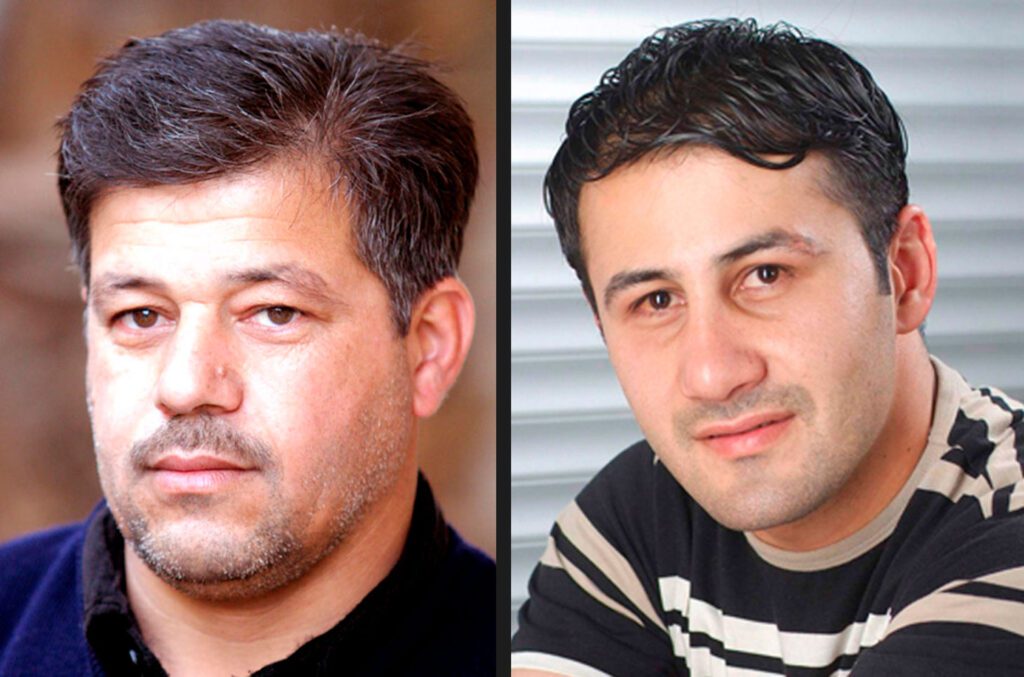
Four days later, after the US military returned Noor-Eldeen’s cameras to Reuters, Dean Yates filed this story questioning the conflicting versions of events in Iraq and seeking answers from the U.S military …
Reuters seeks U.S. probe into killing of Iraqi staff
17 July, 2007 BAGHDAD (Reuters) – Reuters on Monday asked the U.S. military to conduct a full and objective investigation into the killing last week of two of its staff in Iraq after evidence emerged casting doubt on explanations given for their deaths.
Photographer Namir Noor-Eldeen, 22, and driver Saeed Chmagh, 40, were killed in Baghdad on Thursday in what witnesses said was a U.S. helicopter attack and which police in a preliminary report called “random American bombardment”.
The U.S. military in a statement issued just after midnight on Thursday described the incident as a firefight with insurgents. It has said the killings were being investigated.
“Our preliminary investigation raises real questions about whether there was fighting at the time the two men were killed,” said David Schlesinger, editor-in-chief of Reuters.
“For the sake of their memory and for the sake of all journalists in Iraq we need a thorough and objective investigation that will help us and the military learn lessons that will improve the safety of journalists in the future.”
Residents and witnesses interviewed by Reuters said they saw no gunmen in the immediate area where Noor-Eldeen and Chmagh were killed in Baghdad’s al-Amin al-Thaniyah neighbourhood.
They said they were not aware of any clashes in the area leading up to the Apache helicopter attack around 10.30 am local time.
On Sunday, the U.S. military returned to Reuters two digital cameras that belonged to Noor-Eldeen which were taken by American soldiers from the site of the deaths.
No pictures taken by Noor-Eldeen on July 12 show clashes between militants and U.S. forces. The pictures show no gunmen, nor residents running for cover.
The U.S. military said last week it had called in “attack aviation reinforcement” after coming under fire from small arms and rocket-propelled grenades.
Nine insurgents and two civilians “reported as employees for the Reuters news service” were killed, the statement said.
What appears to be the last picture taken while Noor-Eldeen was alive is on his wide-angled lens camera. It came some 10 minutes after he photographed the two women.
The picture shows the top of someone’s head who appears to be falling to the ground or crouching as dust sprays off the top of a wall.
Some 20 minutes later several shots on the wide-angled lens camera show the lower legs of a U.S. soldier and another soldier’s shadow. It appears the camera is being carried and being bumped by a leg, resulting in several frames being shot.
More than three hours later, two more pictures were taken on the wide-angled lens camera. They show a slightly out of focus American soldier sitting in what appears to be a barrack.
Excerpt from Reuters story filed 17 July, 2007 By Reuters Iraq Bureau Chief, Dean Yates
Reuters seeks U.S. probe into killing of Iraqi staff
Mr Yates continues with quotes from David Schlesinger, editor-in-chief of Reuters …
ACCESS TO EVIDENCE SOUGHT
Schlesinger said Reuters was seeking the following from the U.S. military in Baghdad:
** An explanation of why the two cameras were confiscated.
** Access to any cameras onboard the Apache helicopters that were involved in the incident.
** Access to any voice communications between the helicopter crews and U.S. ground forces.
** Access to reports from the unit involved in the incident, in particular a log of any weapons taken from the scene.
Noor-Eldeen and Chmagh were among three Reuters employees killed in Baghdad in the past week.
Excerpt from Reuters story filed 17 July, 2007 By Reuters Iraq Bureau Chief, Dean Yates
Reuters seeks U.S. probe into killing of Iraqi staff
While Reuters were busy during that first week interviewing eye witnesses and consoling Reuters staff, the U.S. military brass were also busy preparing a report into the shootings.
General Vincent K. Brooks signed off on the orders for the investigators on 13 July, the day after the deaths. The investigation was ordered to report back by 19 July.
Gen. Brooks wrote these recommendations before the investigation began. Brooks already blamed the Reuters men for not wearing identifying vests and not notifying the U.S. Military they were in the area.


… Next, we’ll look in detail at the investigation report that General Brooks had ordered into the deaths of Namir Noor-Eldeen, Saeed Chmagh and at least ten other people in Baghdad …
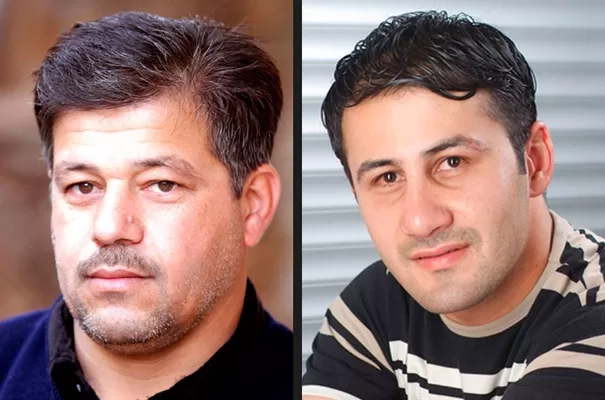

As a former Reuters photographer, I am compelled to look into what happened that day and ask if the military response was appropriate and proportionate. Let’s look at who said and did what in the hours and months after the slaying of Namir Noor-Eldeen and Saeed Chmagh.
More in our Julian Assange series
This background to Julian Assange’s story is part of our investigation into the death of Reuters cameramen in Iraq and the Wikileaks Collateral Murder leak. Our ten page investigation into the death of Reuters camera crew in Iraq.
A quick update on the Julian Assange story
1 The trial of Julian Assange exposes US Rules of Engagement
2 US Military killed two Reuters photographers in Iraq
3 The fix is in: Military investigation into deaths of Reuters staff in Iraq
4 Generals Brookes & Fox meet the Reuters editors
5 Military ignored FOI requests for video of deaths
6 Rules of Engagement between military & civilians
7 Assange: WikiLeaks release Collateral Murder video
8 Definitions, Resources, Transcripts, Apache details
9 Who, what, when and why of the Assange case
10 Wikileaks Collateral Murder video aftermath. Where are they now?


